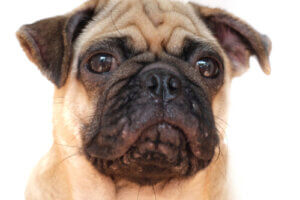Characteristics and Treatments for Acne in Dogs


Written and verified by the vet Juan Pedro Vazquez Espeso
Just like with people, acne can appear in dogs as soon as they reach sexual maturity. They’re more prone to it as soon as they begin to undergo a series of hormonal changes. However, they don’t begin to grow hair where there wasn’t any and also lack the teenage tendency to defy established norms.
Acne has less incidence in dogs, though. Continue reading to find out more about it and its possible treatments.
Acne in dogs
This is an inflammatory process and its main characteristics are folliculitis and furunculosis, that is to say, common pimples. It appears in the facial region of the animal, specifically on the chin and lips, just as it does in humans.
This condition mainly afflicts young animals and short fur breeds such as Boxers, English bulldogs, Rottweilers, and Pinschers.
The role of hormones in the development of this type of process has always been thought to be relevant. However, recent studies speculate that racial predisposition and genetics also play a significant role in the appearance of acne in dogs.

Treatment for acne in dogs
As for therapeutic considerations, one must take into account the intensity and chronicity of this condition. This is because acne in dogs can either be mild and not clinically important, or it can manifest with bad lesions that require aggressive treatment. In this respect, the treatment possibilities can:
Reduce trauma and scratching
This is an important thing to keep in mind when treating animal diseases. This is because you can’t explain to your dog that scratching is a bad idea and thus you must resort to protective measures. There are many devices to keep them from scratching their wounds such as Elizabethan collars. You should also protect those areas in which the animal might try to scratch themselves — rugs and sofas, among others.
Limit foods that cause salivation
Saliva moistens the affected areas, creating an ideal breeding ground for bacteria to grow. Thus, keep the area as dry as possible.
We already know there are dogs that salivate by the mere thought of food on their bowl. So refrain from giving them bones or hard snacks as these increase saliva production.
Clean the area frequently
It’s important to keep the area clean and dry to reduce the concentration of bacteria along with the moisture content of the area. There are shampoos specifically designed for this purpose and also antiseptics you can use. In this respect, try to keep the dog entertained after applying them in order to keep them from licking it off.
Don’t pop the pimples
Of course, this is directed to the dog’s guardians. Popping pimples is a no-no as it would lead to the internal rupture of the pimple and produce a massive inflammatory reaction that could easily worsen the animal’s condition.
Apply systemic medication
Systemic treatments are indicated in refractory cases or in massive infections that compromise the health and welfare of an animal. You can resort to the administration of oral antibiotics in order to avoid these types of complications. Also, the use of corticosteroids is highly recommended for the management of the associated inflammatory syndrome.

Acne in dogs: a conclusion
In conclusion, acne in dogs is a generally benign and self-limiting condition. In most cases, animals can overcome acne without treatment.
However, a clinical picture that compromises the health and well-being of the dog does require treatment. Always consult your veterinarian so they can make a proper diagnosis and prescribe individual treatment.
Just like with people, acne can appear in dogs as soon as they reach sexual maturity. They’re more prone to it as soon as they begin to undergo a series of hormonal changes. However, they don’t begin to grow hair where there wasn’t any and also lack the teenage tendency to defy established norms.
Acne has less incidence in dogs, though. Continue reading to find out more about it and its possible treatments.
Acne in dogs
This is an inflammatory process and its main characteristics are folliculitis and furunculosis, that is to say, common pimples. It appears in the facial region of the animal, specifically on the chin and lips, just as it does in humans.
This condition mainly afflicts young animals and short fur breeds such as Boxers, English bulldogs, Rottweilers, and Pinschers.
The role of hormones in the development of this type of process has always been thought to be relevant. However, recent studies speculate that racial predisposition and genetics also play a significant role in the appearance of acne in dogs.

Treatment for acne in dogs
As for therapeutic considerations, one must take into account the intensity and chronicity of this condition. This is because acne in dogs can either be mild and not clinically important, or it can manifest with bad lesions that require aggressive treatment. In this respect, the treatment possibilities can:
Reduce trauma and scratching
This is an important thing to keep in mind when treating animal diseases. This is because you can’t explain to your dog that scratching is a bad idea and thus you must resort to protective measures. There are many devices to keep them from scratching their wounds such as Elizabethan collars. You should also protect those areas in which the animal might try to scratch themselves — rugs and sofas, among others.
Limit foods that cause salivation
Saliva moistens the affected areas, creating an ideal breeding ground for bacteria to grow. Thus, keep the area as dry as possible.
We already know there are dogs that salivate by the mere thought of food on their bowl. So refrain from giving them bones or hard snacks as these increase saliva production.
Clean the area frequently
It’s important to keep the area clean and dry to reduce the concentration of bacteria along with the moisture content of the area. There are shampoos specifically designed for this purpose and also antiseptics you can use. In this respect, try to keep the dog entertained after applying them in order to keep them from licking it off.
Don’t pop the pimples
Of course, this is directed to the dog’s guardians. Popping pimples is a no-no as it would lead to the internal rupture of the pimple and produce a massive inflammatory reaction that could easily worsen the animal’s condition.
Apply systemic medication
Systemic treatments are indicated in refractory cases or in massive infections that compromise the health and welfare of an animal. You can resort to the administration of oral antibiotics in order to avoid these types of complications. Also, the use of corticosteroids is highly recommended for the management of the associated inflammatory syndrome.

Acne in dogs: a conclusion
In conclusion, acne in dogs is a generally benign and self-limiting condition. In most cases, animals can overcome acne without treatment.
However, a clinical picture that compromises the health and well-being of the dog does require treatment. Always consult your veterinarian so they can make a proper diagnosis and prescribe individual treatment.
This text is provided for informational purposes only and does not replace consultation with a professional. If in doubt, consult your specialist.








